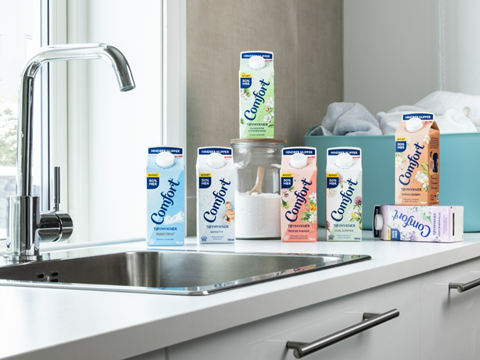
Global packaging company Elopak, Orkla Home and Personal Care (OHPC) and Dow have rolled out a new line of cartons containing a mix of recycled polyethylene and bio-circular (renewable) polymers.
Apparently, the new D-PAK cartons are made from responsibly sourced paperboard, coated with thin layers of polymers to protect the product inside and prevent waste. The thin plastic layer in the new cartons will initially contain 10% post-consumer circular polyethylene (PE).
The other 90% of the PE fraction will be supplied from bio-circular polymers sourced from vegetable-based waste, such as used cooking oil. Elopak says both are sourced and produced through a certified third-party mass balance chain of custody.
The D-PAK cartons are set to become standard across all OHPC products packaged by Elopak throughout the Nordics from this month. This includes brands such as Klar, OMO and Comfort, offering products such as laundry detergent and fabric softener.
Elopak’s customers can choose to include the new mix of recycled and renewable polymers in all Elopak offerings, valid for both blanks and closures. The company states its circular PE will always be combined with bio-circular polymers, in line with its plan to further reduce its carbon footprint.
In May, Elopak launched a paperboard for fresh liquids in chilled distribution chains, said to have a carbon footprint reduction of up to 14% compared to cartons made with standard board. The board is said to offer the same functionality and quality protection as its standard white board, but with a ‘dramatic reduction’ in carbon emissions.
The same month Niederwieser Group, Dow and Kuraray joined forces to create recyclable vacuum bags for the food industry, aiming to meet the upcoming PPWR requirements, ensure legal compliance and reduce environmental impact. The bags’ high-performance oxygen barrier is said to keep food fresh for longer, and the new vacuum packaging offers a ‘cost-effective alternative’ to conventional bags without compromising performance.
If you liked this story, you might also enjoy:
The ultimate guide to the Packaging and Packaging Waste Regulation in 2025
How are the top brands progressing on packaging sustainability?
Everything you need to know about global packaging sustainability regulation in 2025
The key to increasing the use of reusable packaging in supermarkets


















No comments yet